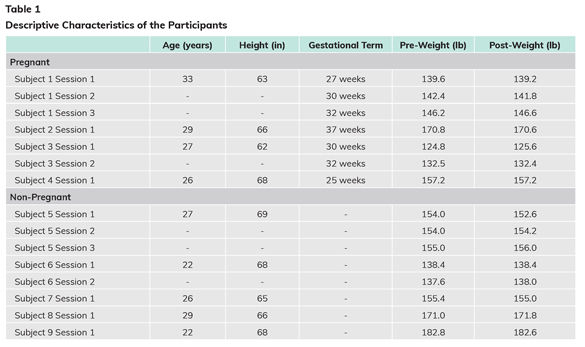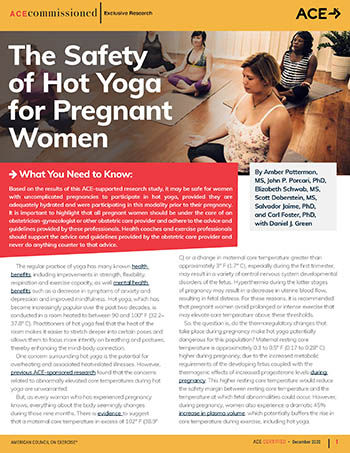
Amber Patterman, MS, John P. Porcari, PhD, Elizabeth Schwab, MS, Scott Doberstein, MS, Salvador Jaime, PhD, and Carl Foster, PhD, with Daniel J. Green
What You Need to Know
Based on the results of this ACE-supported research study, it may be safe for women with uncomplicated pregnancies to participate in hot yoga, provided they are adequately hydrated and were participating in this modality prior to their pregnancy. It is important to highlight that all pregnant women should be under the care of an obstetrician-gynecologist or other obstetric care provider and adhere to the advice and guidelines provided by these professionals. Health coaches and exercise professionals should support the advice and guidelines provided by the obstetric care provider and never do anything counter to that advice.
The regular practice of yoga has many known health benefits, including improvements in strength, flexibility, respiration and exercise capacity, as well mental health benefits such as a decrease in symptoms of anxiety and depression and improved mindfulness. Hot yoga, which has become increasingly popular over the past two decades, is conducted in a room heated to between 90 and 100° F (32.2–37.8° C). Practitioners of hot yoga feel that the heat of the room makes it easier to stretch deeper into certain poses and allows them to focus more intently on breathing and postures, thereby enhancing the mind-body connection.
One concern surrounding hot yoga is the potential for overheating and associated heat-related illnesses. However, previous ACE-sponsored research found that the concerns related to abnormally elevated core temperatures during hot yoga are unwarranted.
But, as every woman who has experienced pregnancy knows, everything about the body seemingly changes during those nine months. There is evidence to suggest that a maternal core temperature in excess of 102° F (38.9° C) or a change in maternal core temperature greater than approximately 3° F (1.7° C), especially during the first trimester, may result in a variety of central nervous system developmental disorders of the fetus. Hyperthermia during the latter stages of pregnancy may result in a decrease in uterine blood flow, resulting in fetal distress. For these reasons, it is recommended that pregnant women avoid prolonged or intense exercise that may elevate core temperature above these thresholds.
So, the question is, do the thermoregulatory changes that take place during pregnancy make hot yoga potentially dangerous for this population? Maternal resting core temperature is approximately 0.3 to 0.5° F (0.17 to 0.28° C) higher during pregnancy, due to the increased metabolic requirements of the developing fetus coupled with the thermogenic effects of increased progesterone levels during pregnancy. This higher resting core temperature would reduce the safety margin between resting core temperature and the temperature at which fetal abnormalities could occur. However, during pregnancy, women also experience a dramatic 45% increase in plasma volume, which potentially buffers the rise in core temperature during exercise, including hot yoga.
To learn more, ACE enlisted the help of John P. Porcari, PhD, and his research team in the Department of Exercise and Sport Science at the University of Wisconsin–La Crosse. The primary purpose of this research was to evaluate and compare core temperature responses during pregnancy and in non-pregnant women during a 60-minute hot yoga class to determine whether this exercise modality is safe for women during uncomplicated pregnancies.
The Study
Before diving into this research, there are a couple of important things to note:
- First, this research addresses hot yoga only, not Bikram yoga, which is performed in considerably hotter rooms [105° F (40.6° C) with 40% humidity] and during which hydration is not actively encouraged. Proper hydration is encouraged during hot yoga—and any other form of exercise—for all exercisers, especially women who are pregnant.
- Second, none of the findings of this research should override the guidance of a pregnant woman’s obstetric care provider. In all cases, exercise professionals and health coaches must adhere to the guidelines and recommendations provided.
Four pregnant women and five non-pregnant women participated in this research. All nine women were apparently healthy, beyond the first trimester and between the ages of 22 and 33 years old (see Table 1, below). All were regular practitioners of hot yoga for at least three months prior to the start of the study.
During each yoga session, core temperature was measured using an ingestible pill. In addition, heart rate (HR) and rating of perceived exertion (RPE) data were gathered to further quantify their responses to the hot yoga session. All of these values were gathered every 10 minutes throughout each 60-minute class. Finally, the investigators measured any changes in body weight as well as the amount of fluid consumed during class.
The temperature and humidity of the exercise studio increased steadily throughout each class and averaged 95.7° F (35.4° C) and 56.7% humidity.
Three yoga sessions were offered, though not all of the women participated in all three (Table 1). Among the four pregnant women, one completed three sessions, one completed two sessions, and two completed only one session. Among the five non-pregnant women, one completed three sessions, one completed two sessions, and three completed only one session.
Dr. Porcari points out that because of the low number of participants in this research, this is purely an observational study, meaning that no real statistical analysis is possible.

The Results
Body Weight and Fluid Consumption
Overall, there was no change in average body weight of either the pregnant or non-pregnant women during the yoga session (see Table 1).
The pregnant and non-pregnant women consumed similar amounts of water during the 60-minute class (9.1 ± 8.15 ounces and 9.2 ± 6.94 ounces, respectively).
Heart Rate and Rating of Perceived Exertion
HR during the class averaged 105 beats per minute (bpm) and 99 bpm for the pregnant and non-pregnant women, respectively (Table 2). RPE (which was measured using the 6−20 scale) averaged 10.5 for the pregnant women and 9.9 for the non-pregnant women, with both groups reporting their highest RPE values at the mid-point of the class (see Table 2).

Core Temperature
Average core temperatures for all participants, across all sessions, are presented in Figure 1.

Figure 1. Mean core temperatures of the pregnant and non-pregnant subjects collapsed across all sessions for each group.
The average highest core temperature (recorded at any time during a class) for the non-pregnant women was 99.9° F (37.7° C), which was actually slightly higher than the average among the pregnant women (99.5° F; 37.5° C). Similar results were recorded when the researchers looked at the single highest core temperature recorded, which was 101.4° F (38.6° C) for the non-pregnant women and 100.1° F (37.8° C) for the pregnant women. The change in core temperature for the pregnant women in any one class ranged from –0.19 to 1.2°F (−0.11 to 0.67° C), while the change among the non-pregnant women ranged from 0.29 to 2.8° F (0.16 to 1.6° C).
The Bottom Line
One concern regarding the practice of hot yoga by women during pregnancy is a potentially dangerous increase in core temperature. A maternal core temperature exceeding 102°F (38.9° C) or an increase of 3° F (1.7° C) from baseline has been suggested to increase the risk for abnormal fetal development.
As mentioned above, none of the pregnant women saw their core temperature exceed 100.1° F (37.8° C), well below that dangerous threshold. In addition, none of the pregnant participants had a change in core temperature that exceeded 1.2° F (0.67° C).
Stated simply, the results of this study suggest that hot yoga may be safe for women with uncomplicated pregnancies who participated in this modality prior to pregnancy and who take steps to ensure they are adequately hydrated. Of course, the final decision as to whether to participate in hot yoga should be made jointly by the expectant mother and her obstetric care provider—and an exercise professional or health coach should support that decision.
Dr. Porcari points out that the pregnant participants tended to “spontaneously down-regulate” their intensity by either modifying or avoiding certain poses, even though they were not specifically cued to do so. This included modifying or avoiding movements that featured core work, twisting or bending. “This is important,” says Porcari, “because any decrease in intensity will also decrease the thermal load.”
“The safety of hot yoga for pregnant women is an important message for health coaches and exercise professionals to share with their participants and clients, as it’s further proof that during pregnancy women should not shut down what they’d been doing prior to becoming pregnant,” Porcari says. That said, he reminds us one last time that health coaches and exercise professionals must always check with a client’s or participant’s obstetric care provider, as they may be aware of underlying complications with the pregnancy, such as an elevated blood pressure, gestational diabetes or other contraindications to this type of workout.
This study, which was supported by the American Council on Exercise, was first published in the peer-reviewed
International Journal of Research in Exercise Physiology.





 by
by 









